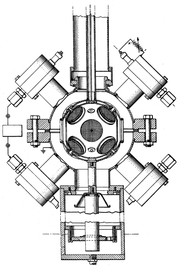Inertial electrostatic confinement
A company called NSD-Gradel developed a compact IEC device that fused ions and created neutrons and sold the product for several hundred thousand dollars.
This sort of voltage is easily achieved in common electrical devices; a typical cathode-ray tube operates in this range.
Mark Oliphant adapts Cockcroft and Walton's particle accelerator at the Cavendish Laboratory to create tritium and helium-3 by nuclear fusion.
[7] This puts on minimum criteria on power plant designs which do fusion using hot Maxwellian plasma clouds.
Also, work exploring how electrons behave inside the biconic cusp, done by Harold Grad group at the Courant Institute in 1957.
In 1962, he filed a patent on a design using a positive inner cage to concentrate plasma, in order to achieve nuclear fusion.
[11] During this time, Robert L. Hirsch joined the Farnsworth Television labs and began work on what became the fusor.
Meanwhile, magnetic mirror theory and direct energy conversion were developed by Richard F. Post's group at LLNL.
[17][18][19] Bussard patented[20] the design and received funding from Defense Threat Reduction Agency, DARPA and the US Navy to develop the idea.
[22][23] In response, Todd Rider at MIT, under Lawrence Lidsky developed general models of the device.
[25] Nevins argued that the particles would build up angular momentum, causing the dense core to degrade.
At this time in Europe, an IEC device was developed as a commercial neutron source by Daimler-Chrysler Aerospace under the name FusionStar.
Despite demonstration in 2000 of 7200 hours of operation without degradation at high input power as a sealed reaction chamber with automated control the FusionStar project was canceled and the company NSD Ltd was founded.
The spherical FusionStar technology was then further developed as a linear geometry system with improved efficiency and higher neutron output by NSD Ltd. which became NSD-Fusion GmbH in 2005.
In response to Riders' criticisms, researchers at LANL reasoned that a plasma oscillating could be at local thermodynamic equilibrium; this prompted the POPS and Penning trap machines.
In 2005, Greg Piefer founded Phoenix Nuclear Labs to develop the fusor into a neutron source for the mass production of medical isotopes.
[46] Bussard's publications prompted the University of Sydney to start research into electron trapping in polywells in 2010.
[56] Avalanche Energy is a start-up with about $51 million in venture/DOD funding that is working on small (tens of centimetres), modular, fusion batteries producing 5kWe.
The magnetic field strength is targeted to exceed a Hull cut-off condition, ranging from 50-4,000 kV.
Fusors are popular with amateurs,[58] because they can easily be constructed, can regularly produce fusion and are a practical way to study nuclear physics.
They can be dangerous if proper care is not taken because they require high voltages and can produce harmful radiation (neutrons and X-rays).
Their device (PFX) was a small (millimeters) and low power (one fifth of a tesla, less than ten thousand volts) machine.
[74] In 1995, Todd Rider critiqued all fusion power schemes using plasma systems not at thermodynamic equilibrium.
Other fusion researchers such as Nicholas Krall,[75] Robert W. Bussard,[68] Norman Rostoker, and Monkhorst disagreed with this assessment.
They argue that the plasma conditions inside IEC machines are not quasineutral and have non-thermal energy distributions.
This may allow the plasma to be optimized, whereby cold electrons would reduce radiation losses and hot ions would raise fusion rates.
Rider focused his arguments within the ion population and did not address electron-to-ion energy exchange or non-thermal plasmas.
Rider estimated that once the plasma is thermalized the radiation losses would outpace any amount of fusion energy generated.
[24] In 1995, Nevins argued that such machines would need to expend a great deal of energy maintaining ion focus in the center.
In 1945, Columbia University professor Léon Brillouin, suggested that there was a limit to how many electrons one could pack into a given volume.





